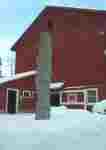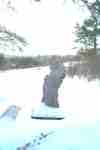Ken Hiratsuka's Endless Line
by Gordon Fitch

















When I first saw one of Ken Hiratsuka's stones, I could not tell immediately whether it was a work of art, an artifact of some primitive and and mysterious religion, or perhaps even the product of prehuman, even extraterrestrial, geological processes. This was at Christine Louisy-Daniel's Fire Patrol Five Gallery which was then gracing 121st Street in Harlem. (It has since been overwhelmed by the juggernaut of Real Estate Values.) The stone's overall shape was irregular and rounded, like any rock one might find in a New England field, but it was covered with a pattern of lines (actually, a single line) quite unlike anything I had ever seen before. Once I got a good look at it, various patterns in the meanderings of the lines suggested themselves. The stone spoke, but in a strange language. Assured that it was a work of art, I sought out the artist, Ken Hiratsuka.
Somewhat later I got a chance to observe a large body of his work in his studio at 516 East 11th Street in New York City. The studio is in the basement where the concrete floors and brick walls afford the heavy objects he works with the necessary strong support, and, I think, a resonant sense of being close to the world's rocky core. (Hiratsuka also maintains a studio near the town of Andes in the northern Catskills, where some of the pictures in this article were taken.) Besides studio work, Hiratsuka has made his carvings in situ, on sidewalks and walls and natural outcroppings of rock. The work with which Hiratsuka initiated his one-line concept was the granite sidewalk at the northwest corner of the intersection of Prince Street and Broadway in New York City. It is no doubt one of the most walked-on works of art in the world. (Later, the Guggenheim Museum chose this corner for its Soho branch.)
The lines sometimes appear to be random, but they are not. First of all, each line is endless (although some may run off the edge of the stone), so that the many lines on a rock are all one. While this fact is not immediately obvious to the viewer, one seems to intuit it; the inscriptions are coherent and hang together, rather than seeming to fly apart or to point away from their matrix.
(The concept of creating elaborate works of art from a single line is not new; however, it has mostly been done in drawing and calligraphy, and often as a trick or a hurdle, rather than as a concept which relates to the import of the work.)
Hiratsuka envisions his lines as actually running around and uniting the whole earth. Furthermore, in most cases the lines follow or respond to not only the shape of the stone (which usually remains basically unchanged) but to higher-level geometrical abstractions like circles and stars which exist in the artist's mind and sometimes lightly traced on the stone as well before it is carved, and also to such lower-level subtleties as the surface texture and color of the material. The kind of line depends on the shape and size of the stone and the material it is made of: a thin line can be inscribed in slate, but granite demands broad, deep cuts. The work ranges in size from small stones that might be used as a desk paperweight, to large monumental objects standing twenty or thirty feet high and weighing several tons.
Not all of Hiratsuka's work is abstract; some of it is fairly representational, even humorous. In one case, a line across a rock reveals trees, buildings, persons and animals -- it's the record of a journey. In others, the shape of the rock may remind the viewer of an animal or a geographical area, and the line inscribed on it may comment on that association. A few stones turn out to be "books" with, of course, the endless line written on them for their texts. Besides carving one-line works in stone, Hiratsuka has also created similar objects in iron and as drawings. It is plain that he has become fluent in this scriptural language he has worked out, capable of both serious and light modes of discourse, without in any way departing from its long spiritual roots in geolocial processes and prehistoric art.
Since Hiratsuka's work is sui generis, being at once sculpture and yet something besides sculpture, conceptual and yet sensual, new yet very old, it is hard to place it in the framework of any academic or commercial scheme of categorization or evaluation. It needs to be experienced directly, and the viewers must take their own advice as to what it means to them.
In addition to the pictures associated with this article, one can see others at Hiratsuka's web site, www.kenrock.com especially some of the monumental works which are now in place all over the world. However, as with any sculpture, pictures speak far less than a thousand words, and it's best to see and savor them personally.
























Text copyright © 2004 Gordon Fitch
 back to Contents page
back to Contents page